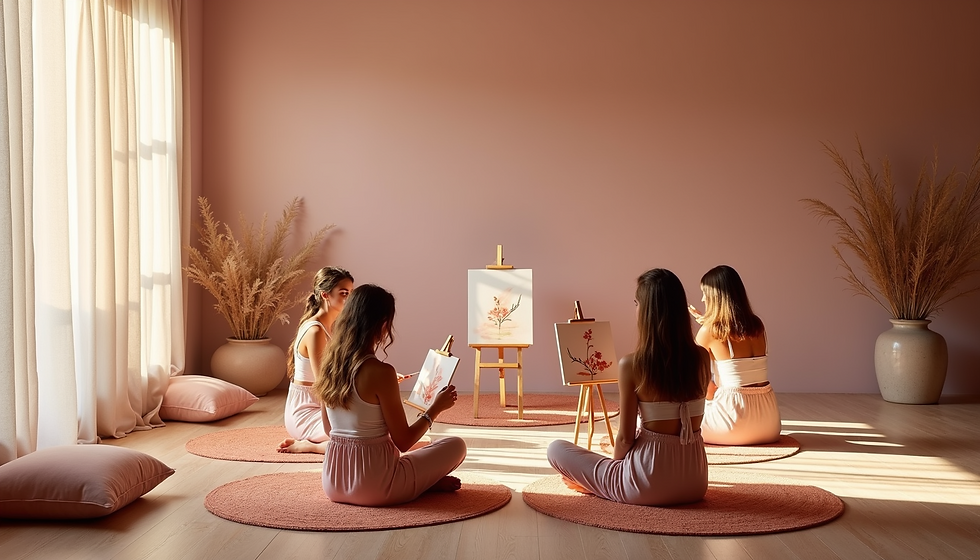How to Bring Art Therapy Into Your Practice — Without Breaking Scope
- makeartwithtraci
- 4 days ago
- 4 min read
A practical guide for private practice owners who want to expand their services creatively, ethically, and confidently.

The Vision You Already Have
You can offer creative, healing experiences — without new credentials or added stress.
As a private practice owner, you’re passionate about giving your clients the best care possible — approaches that are relevant, holistic, and meaningful. You’ve probably noticed how art and creativity can help people open up, regulate emotions, and express what words can’t.
But here’s the problem: you’re not credentialed in art therapy, and you’re not sure what’s ethically allowed. Maybe you’ve thought, “I’d love to offer this, but I don’t want to cross a professional line.”
This guide will show you exactly how to bring the magic of art therapy into your practice safely, ethically, and beautifully — through collaboration with a credentialed facilitator.
You’ll discover:
✅ What art therapy really is (and what it isn’t)
✅ What’s within your ethical and professional scope
✅ Three ways to integrate art therapy into your practice
✅ How to collaborate with a credentialed art therapist
What Art Therapy Really Is-

The Difference Between “Art Activities” and True
Art Therapy
Art therapy is more than just creative expression — it’s a professional mental health discipline. Credentialed art therapists are trained to combine the creative process with psychotherapy principles to help clients explore emotions, process trauma, and build resilience.
In other words, it’s not about being “good at art.” It’s about helping people find meaning through making.
Led by professionals: Licensed and board-certified art therapists (ATR, ATR-BC, LPC-AT, etc.) integrate creative expression with evidence-based approaches like CBT, DBT, mindfulness, and trauma-informed care.
When offered by qualified facilitators, art therapy can:
🎨 Deepen insight and emotional awareness
🧠 Improve outcomes for clients who struggle to verbalize emotions
💬 Increase engagement in group settings
🌿 Support clinician well-being and creativity
Scope and Ethics: What’s Allowed (and What’s Not)
Understanding Your Role as a Practice Owner
You absolutely can bring art therapy to your clients — you just need to do it in collaboration with a credentialed art therapist.
✅ You CAN:
Offer art therapy groups facilitated by a credentialed art therapist.
Market your practice as offering art therapy or creative group programs (as long as you specify who leads them).
Support your clinicians with creative professional development or self-care workshops led by a credentialed facilitator.
🚫 You SHOULD NOT:
Advertise “art therapy” if no credentialed facilitator is involved.
Ask non-art-therapist staff to lead “art therapy” sessions.
Use art as a clinical tool without appropriate training.
Why this matters: Staying within your ethical and professional scope protects you, your clients, and your reputation — while still allowing your practice to evolve creatively and offer powerful new experiences.
Three Ethical Ways to Integrate Art Therapy
Creative Expansion — Done the Right Way

You don’t have to do more work to offer more healing. Here are three ways to integrate art therapy ethically and effectively:
Option 1: Partner with a Credentialed Art Therapist (Like Me!) Collaborate with a professional who can design and facilitate group sessions within your practice. This approach keeps everything above board while allowing you to expand your services immediately.
Option 2: Offer Specialized Art Therapy Workshops or Retreats. Think seasonal, thematic, or issue-specific: grief processing, burnout recovery, self-discovery, or stress reduction. You provide the audience — your facilitator handles the rest.
Option 3: Support Your Team Through Art-Based Self-Care. Host creative clinician wellness sessions to nurture your staff’s mental health. These art-based experiences reduce burnout, boost morale, and foster authentic connection within your team.
Each of these approaches allows your practice to grow without overextending you or your staff.
Collaboration Made Simple-
How It Works When We Partner
You don’t need to navigate this alone. Here’s what collaboration looks like:
Step 1 — Consultation: We’ll start with a free 30-minute call to explore your goals, client populations, and desired outcomes.
Step 2 — Design & Facilitation: I’ll create and facilitate tailored art therapy groups or workshops aligned with your practice’s needs and values.
Step 3 — Implementation: Your practice adds a new, in-demand service — fully compliant, creative, and clinically grounded.
Together, we’ll design something that enhances your clients’ healing journey and makes your practice stand out as a leader in holistic care.
Bring Art Therapy to Your Practice
Expand Your Services. Support Your Clinicians. Transform Client Care.
Adding art therapy to your practice doesn’t have to be complicated. With the right collaboration, you can:
✅ Expand your offerings without new credentials
✅ Improve outcomes and engagement for your clients
✅ Reduce burnout and foster creativity among your clinicians
✅ Enhance your reputation as a forward-thinking, holistic practice
If you’ve been wondering how to integrate art therapy ethically and effectively, this is your next step.
🗓️ Book your free 30-minute “Art Therapy Collaboration Call.”Let’s explore creative group offerings that align with your mission, your clients, and your care model.



Comments